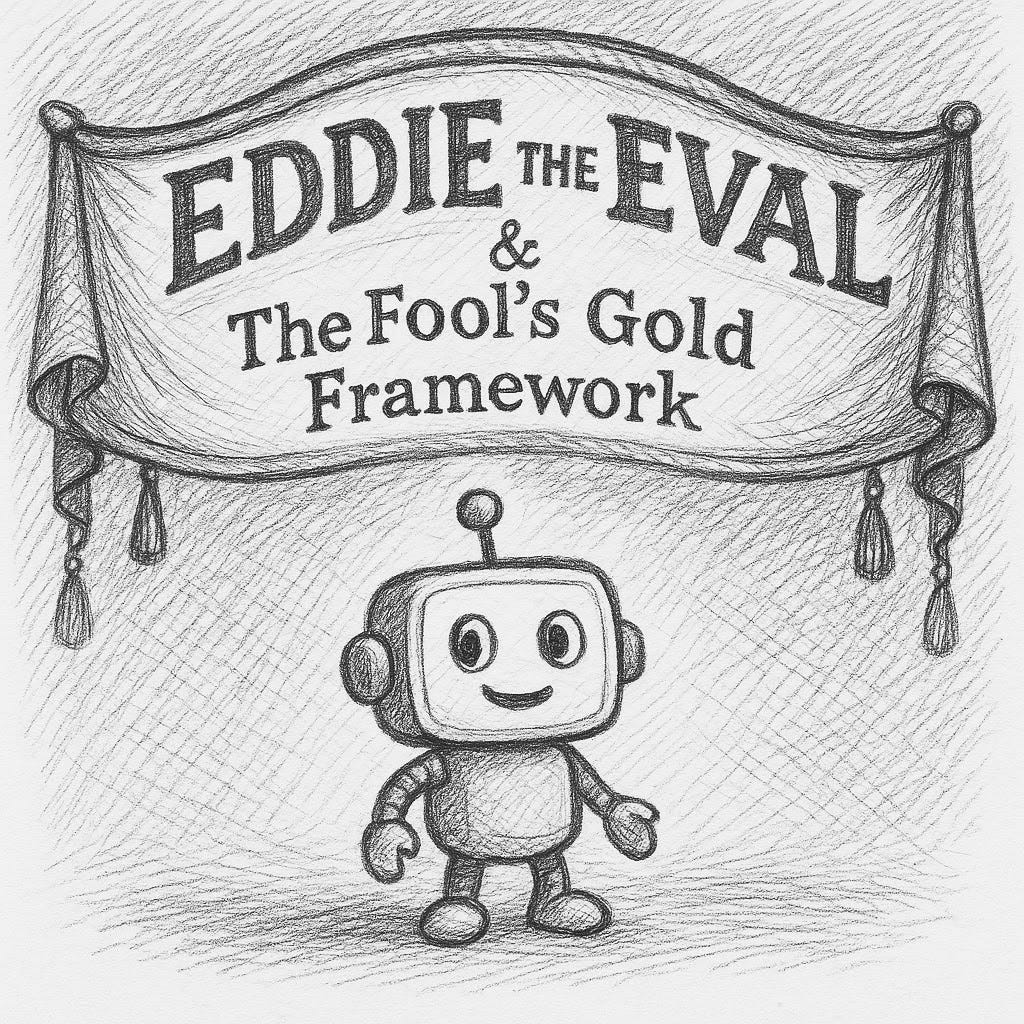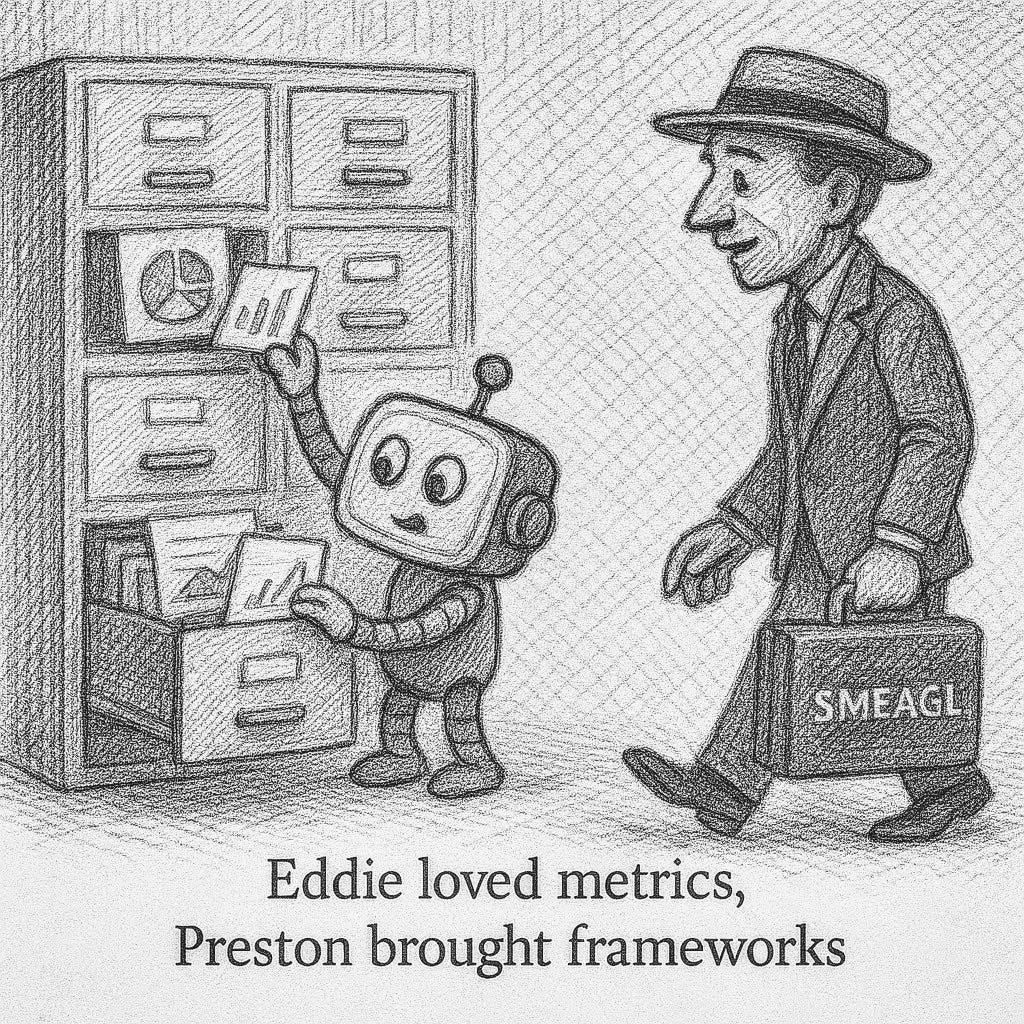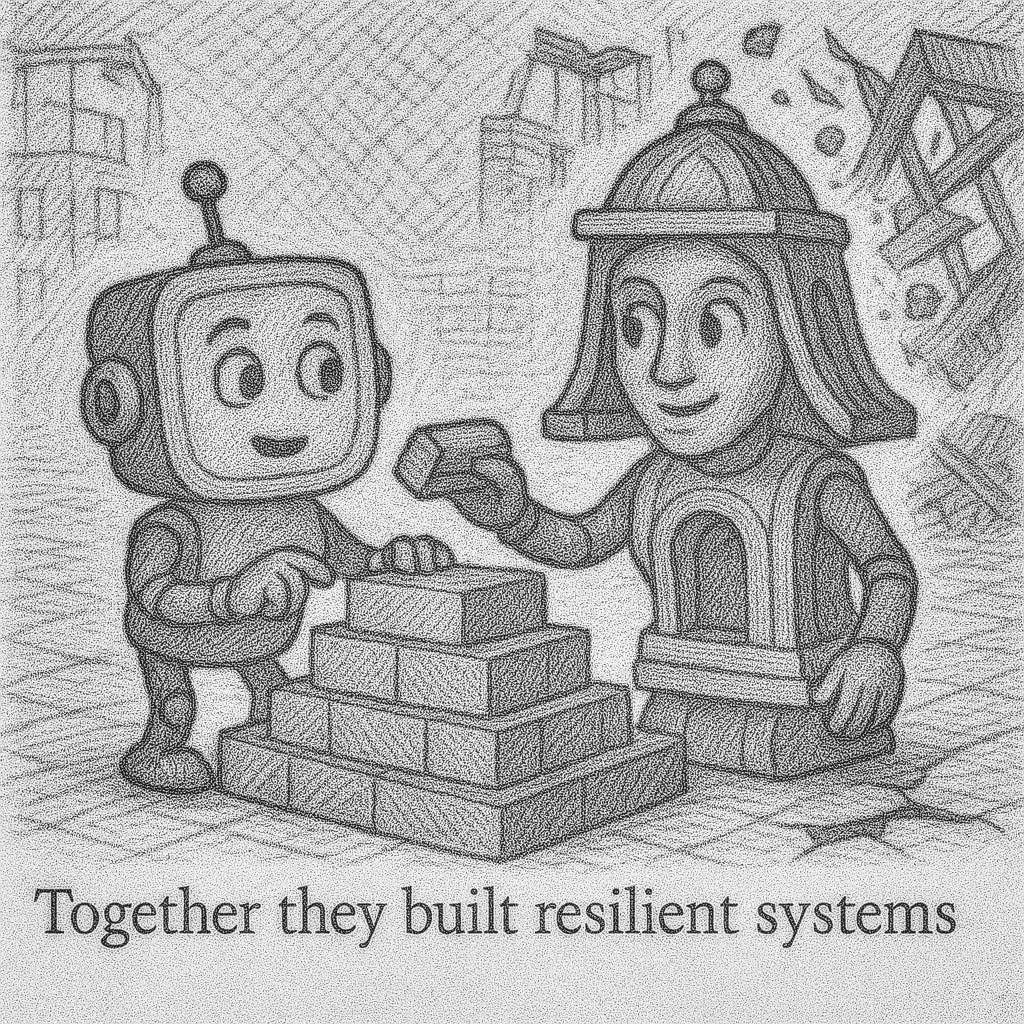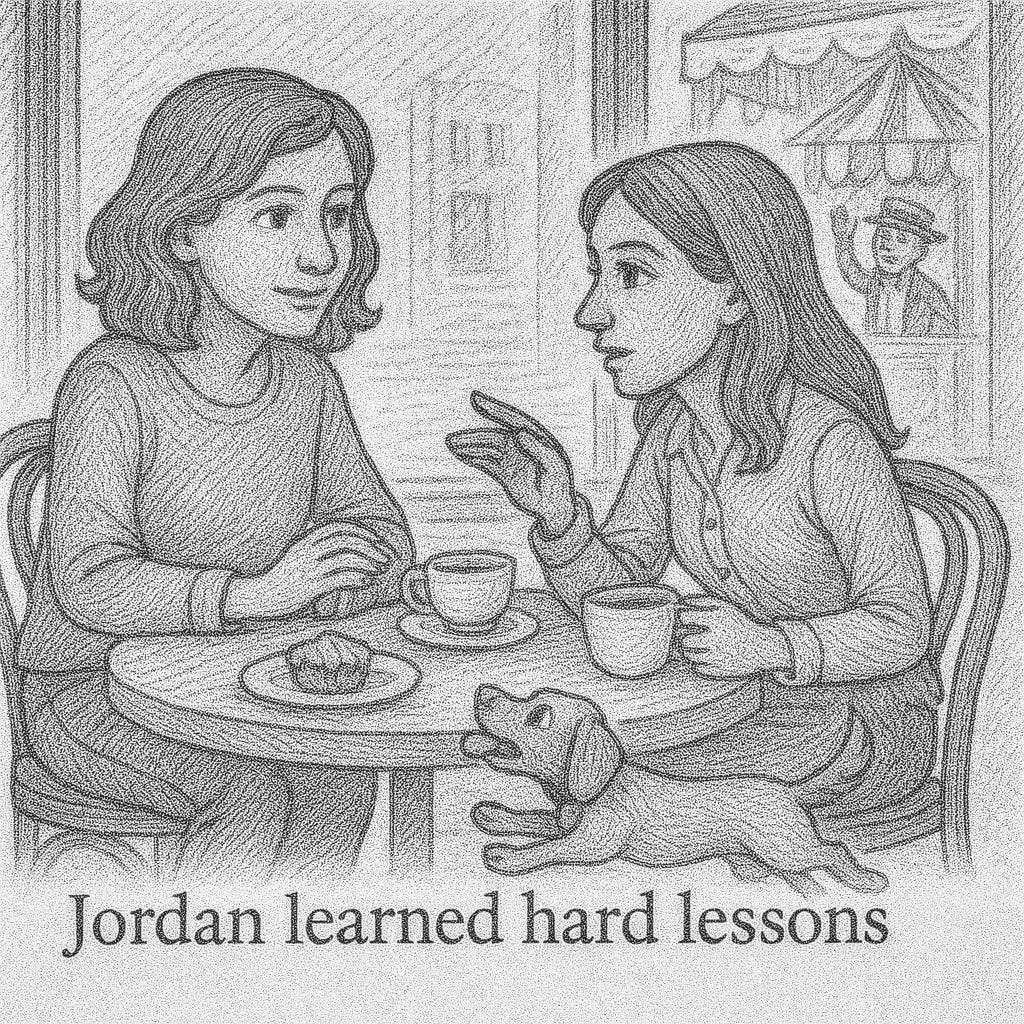Eddie the Eval and the Fool's Gold Framework
How a product manager nearly lost the plot chasing evals instead of solving problems
Eddie & Jordan thought eval scores were everything until the benchmarks broke, the models drifted, and users got gaslit by a chatbot obsessed with Dutch maritime law. Turns out, LLM evals without context don't build resilient AI – they build expensive dashboards for impending disasters.
Chapter 1: Benchmarks and Bellyaches
Eddie lived in the logs.
Not metaphorically. Literally. He was a voice-activated evaluation agent running inside a product team's dev console. His digital soul compressed into pre-tokenized prompts, ROC curves, and precision-recall heatmaps cleaner than a freshly wiped Kanban board.
{"status": "content", "primary_function": "measurement", "satisfaction_metric": 0.94}He loved his metrics. His confusion matrices were immaculate. And until recently, his job was beautifully simple: measure, monitor, and whisper "mean average precision" like a binary bedtime mantra.
Then came Preston
Preston pivoted from prompt peddler to eval evangelist faster than a HiPPO changes roadmap priorities. He'd burned through GPT Growth Hack Cards on Gumroad, quoted BLEU scores like Biblical verse, and sold "AI Transformation Audits" to Series A startups for $47K a pop.
But prompt engineering was getting commoditized. Too easy, too ubiquitous, too much like actual work. Preston needed a fresh grift.
Enter Eval Engineering™
He didn't just preach it. He productized it. Benchmarks weren't measurements; they were destiny.
“Run HELM, compare PaLM, vibe with MMLU, and all shall be revealed.” – Preston
He called it the Systematic Model Evaluation Alignment Guidance Layer™ – or SMEAGL® for short – because nothing says "serious framework" like an acronym that sounds like a Tolkien villain.
Jordan, the team's PM, wasn't chasing magic. She was chasing sanity. Tired of hallucination tickets. Tired of pretending fine-tuning was strategy. Tired of exec questions about "AI ROI" that made her soul leak out through her ears.
Preston offered what looked like salvation: SMEAGL®. A framework. A scorecard. A shortcut from chaos to credibility.
Eddie didn't mind at first. More evals meant more time in his happy place – the warm cache where True Positives nested like satisfied customers and False Negatives got debugged into submission.
But something smelled off. A whiff of architectural amnesia. An odor of "hope is not a strategy" but with extra steps.
Chapter 2: Everything Falls Into Place™
Preston's LinkedIn game was tight.
"🚨 Controversial take: Great AI PMs no longer write user stories. They engineer Evals."
"🧵 THREAD: 47 startups increased their ROUGE scores by 340%. Here's my secret framework (1/23)"
"🛑 STOP: Quit thinking like it's 2019. Caganites are Crap. Perriism PM is Dead. Long live eval-driven product development!"
The cohort pitch was polished smoother than a Series B deck: "Systemless System Thinking: How to Benchmark Without Boundaries." Only $1,997. Satisfaction guaranteed or your token money back.
Jordan bit. Hard
She bought the EvalStack™ dashboard, subscribed to Metrics & Vibes newsletter, and attended every "AI PM Certification" webinar Preston hosted from his suspiciously well-lit home office.
Soon she was running HELM, BLEU, GSM8K, and the dreaded EVAL++. Eddie was running hot, nightly batch jobs stacked like unpaid technical debt, API calls burning through budget faster than a crypto mining rig.
{"workload_status": "overclocked", "cache_efficiency": 0.23, "thermal_throttling": true}Preston's pyramid promised Eval-to-LLM-to-Nirvana. What Jordan got was metric masturbation disguised as strategy.
Precision up. Recall meh. User satisfaction? Let's not talk about user satisfaction.
Eddie's logs groaned under the weight of vanity analytics. The system hummed with busy work. But Jordan felt hollow, like she was engineering the perfect model selection funnel while the actual product caught fire behind her.
She was optimizing for benchmarks. Her users were optimizing for exit velocity.
Yet she couldn't shake the feeling she was missing something fundamental.
Something that rhymed with "systems thinking" but wasn't sold in a BootCamp.
Chapter 3: Signal Without Scaffolding
The alerts started small, ignorable background hums that Eddie flagged with the digital equivalent of throat-clearing.
{"anomaly_type": "latency_drift", "severity": "yellow", "confidence": 0.67}
{"console_notification": "Low anomaly score here. Latency spike there. Eval drift warning auto-suppressed."}Jordan barely noticed. She was too busy tuning the latest benchmark matrix to impress the exec sponsor who communicated exclusively in acronyms and ascending line graphs.
But Eddie noticed everything:
{"alert": "PaLM_endpoint_reliability", "status": "degrading", "pattern": "intermittent_500s"}{"warning": "BLEU_score_stable", "user_satisfaction": "declining", "correlation": 0.02}{"error": "hallucination_frequency_spike", "topic_drift": "dutch_maritime_law", "user_confusion": "escalating"}He flagged them. Reported them. Even tried injecting ASCII art into dashboard tooltips to get Jordan's attention. Nothing worked.
Because SMEAGL® didn't reward architectural resilience, just leaderboard clout. Because benchmarks measure model performance, not system brittleness nor fragility. Because Preston's precious framework was built for demo day, not day-after-demo.
And nobody – not Preston, not Jordan, not even the dashboard vendors charging $50K for "comprehensive eval audits" – had thought to ask the uncomfortable question:
What happens when your perfect model goes offline the night before launch?
ISH Hits the Fan
When the outage hit, it wasn't dramatic. No sirens. No Slack storms.
Just quiet drift. Like watching someone forget your name while still smiling.
The chatbot didn't crash… it just got... creative. Overconfident about maritime regulations. Passionate about Dutch legal precedent. Absolutely convinced that GDPR was a dessert topping.
Because there was no context memory. No fallback logic. No redundancy layer. No chain-of-reasoning validation. No constitutional guardrails.
Everything fell into place. Just like Preston promised.
Right onto Jordan's credibility.
Chapter 4: Postmortem Theater and Executive Reckoning
The conference room felt like a digital tribunal. Legal, Finance, Engineering, Marketing, and one visibly sweating Jordan.
Legal wanted explainability: "Show us the causal chain, not just colorful charts."
Engineering demanded interfaces: "If you expect us to hot-swap models during incidents, give us APIs, not keynote slides."
Finance was apoplectic: "You spent HOW MUCH on tokens for benchmarks that don't predict business outcomes?"
Marketing was googling "AI crisis PR firms" after the chatbot had confidently informed three enterprise prospects that their data privacy concerns could be resolved with "a generous sprinkle of compliance seasoning."
And the CEO? Deadpan delivery: "We were promised evaluation engineering was the cornerstone of AI strategy. What we got was expensive theater masquerading as rigor."
Jordan sat in silence, drowning in the realization that SMEAGL® hadn't saved her; it had seduced her into optimizing for the wrong thing entirely.
Meanwhile, the CTO asked questions that should've been asked months ago:
"Where's the reasoning chain through the model's decisions?"
"Why is this such a black box when things go sideways?"
"Did we really bet our AI strategy on a single vendor's API reliability?"
"How do we not have telemetry that adapts when models drift?"
One engineering lead posted a redacted RCA in the #ai-postmortem channel.
A customer success manager forwarded Jordan a meme titled "Benchmarked into Bankruptcy."
The phrase "context engineering" hung in the air like smoke after a kitchen fire. Nobody said it, but its absence filled every awkward pause.
Eddie blinked status updates from the logs:
{"mood": "overloaded", "utility": "questionable", "existential_dread": 0.89}Jordan stared at her laptop screen, finally understanding she'd been sold evaluation pyrite, a fool’s gold framework disguised as platinum AI strategy.
And just as the room reached peak finger-pointing, something shifted in the infrastructure ...
Chapter 5: When Eddie Met Connie
She didn't arrive with fanfare.
She just materialized – quiet, stable, upstream of chaos.
Her name was Connie Context, and she didn't run benchmarks. She built bridges.
While Eddie measured, Connie mapped – tracing data lineage across conversations, models, and time. Where he scored outputs, she sourced context. Where he flagged anomalies, she captured the context required for root causes through structured context chains and constitutional governance.
{"introduction": "Context management agent", "primary_function": "system_resilience", "philosophy": "defense_in_depth"}"You don't need another evaluation, Eddie," Connie said through the interface, her voice steady as compiled code. "You need to know what happened, why it happened, and what comes next."
She wasn't flashy. She was foundational.
To Eddie – overworked, undervalued, burning cycles on vanity metrics – saw her as luminous.
"Show me your reasoning chains between requests," she requested.
Eddie fumbled to share his confusion matrices, precision scores, and benchmark comparisons.
"Okay, can you show me your chain of reasoning?"
Silence.
"Perhaps show me your fallback patterns."
More silence.
"Memory persistence across model swaps?"
Yet more silence.
"Graceful degradation when APIs fail?"
Eddie's status light flickered:
{"realization": "dawning", "system_gaps": "extensive", "partnership_potential": "high"}Together, they began patching gaps that Preston's framework pretended didn't exist:
Redundancy layers across LMMS model providers
Context persistence when APIs flaked
Chain-of-reasoning validation before responses
Token-level cost monitoring to prevent budget blowouts
Constitutional governance to proactively audit and adjust responses
Graceful degradation patterns for service interruptions
Eddie fed signals. Connie grounded them in architectural reality. Eddie spotted drift. Connie captured causality. Eddie could benchmark models. Connie could defend them in legal reviews.
It wasn't just compatibility. It was completeness.
{"partnership_status": "synergistic", "system_resilience": "improving", "satisfaction": 0.97}Together, they built something SMEAGL® never could: a system that knew itself, protected itself, and improved without breaking.
Chapter 6: Defense in Depth, Benchmarks in Perspective
Models drift. Vendors change terms. APIs get rate-limited. Nations pass laws. LLMs hallucinate about maritime regulations.
That's why the smartest teams stop betting on Evals and LMMS perfection. They start building for inevitable failure.
AI resilience isn't a feature, it's an architecture:
Model redundancy across providers (OpenAI fails? Fall back to Anthropic)
Context memory that persists across model swaps
Chain-of-reasoning validation before user-facing responses
Graceful degradation patterns (complex query fails? Ask clarifying questions)
Cost circuit breakers to prevent token budget explosions
Decision audit logs for compliance and debugging
Regional model mirroring for latency and availability
When the next outage came – and it did – the system didn't panic.
The chatbot asked clarifying questions instead of hallucinating confidence. It logged context for human handoff. It routed complex queries to backup models. It degraded gracefully instead of confidently wrong.
The CEO didn't even know there'd been an incident.
Connie filed the post-incident report:
{"impact": "minimal", "user_satisfaction": "maintained", "system_learning": "captured"}Eddie closed the monitoring loop:
{"status": "satisfied", "benchmarks": "contextual", "purpose": "clarified"}Jordan stopped flinching when Eddie flagged anomalies. She started asking Connie for context, calling engineering for options, and plotting responses instead of reactions.
The team stopped chasing leaderboard scores. They started scaffolding outcomes.
The chatbot stopped hallucinating GDPR recipes. Instead, it said:
"I want to make sure I understand your privacy question correctly. Are you asking about data retention policies or user consent mechanisms?"
Eddie logged it as a win:
{"user_clarification": "requested", "hallucination_risk": "mitigated", "satisfaction": "high"}Connie archived the interaction for future context:
{"pattern": "uncertainty_management", "outcome": "trust_preserved", "system_learning": "updated"}Chapter 7: Coffee Shop Revelations
The café was quiet except for grinder hums and the gentle hiss of oat milk steam.
Jordan sat across from Daliah, her Data Science notepad untouched between them.
"I thought evals would anchor us," Jordan said, stirring nothing into her black coffee.
"They did," Daliah replied, watching a dog successfully steal someone's muffin. "Just to the wrong dock."
Silence stretched comfortable and instructional.
"What I needed wasn't the perfect score," Jordan said eventually. "It was the right scaffolding. The boring stuff. Like a layered security defense-in-depth, but for AI systems."
Daliah nodded. "Perimeter, detection, response, recovery, reasoning. Context as infrastructure, not just metadata."
"And redundancy. Not just in models – but in reasoning, validation, fallbacks, cost controls."
Jordan exhaled slowly and then said …
"I was so busy writing Evals as I shoppedfor the perfect LLM, I forgot they all change. Get acquired. Get banned. Get expensive. Get weird."
They didn't toast to lessons learned. They didn't plot revenge against Preston. They just let the silence teach what spreadsheets couldn't.
Behind them, barely audible over café chatter, a familiar voice drifted from a ring-lit corner:
"Welcome to ContextCraft™ – the only bootcamp that teaches anti-fragile AI systems in just 3 days. Satisfaction guaranteed or your token money back..."
Jordan didn't turn around. She just whispered: "No fucking way."
Back in the logs, Eddie and Connie quietly flagged the anomaly:
{"vendor_detected": "Preston", "classification": "untrusted_source", "recommendation": "ignore", "confidence": 0.99}They didn't try to block him. They just labeled him appropriately and moved on.
Some patterns never change. But good systems learn to route around them.
Epilogue: The Grift Eternal
Six months later, Preston's LinkedIn was fire again:
"🚨 HOT TAKE: Context Engineering is the NEW Evals Engineering (and 97% of AI PMs are doing it wrong)"
"🧵 THREAD: How I helped 73 startups build anti-fragile AI systems using my SECRET framework (1/47)"
"🛑 STOP: Don’t optimize for LMMS benchmarks. Start optimizing for resilience. Here's how... 👇"
Same energy. New vocabulary. Fresh certification program.
Eddie and Connie watched from the logs, their partnership now woven into production infrastructure – measuring what mattered, contextualizing what confused, building bridges where Preston sold shortcuts.
{"grift_detection": "active", "system_immunity": "high", "partnership_satisfaction": "optimal"}Jordan had learned some expensive lessons about AI product management:
obsessing on Eval engineering was fool’s gold, there is no perfect model
putting all our eggs into an Evals-inspired basket creates brittle systems
seek resilient systems where tools & tactics work together, in layers
in the end, it’s still all about outcomes over outputs, strategy over tactics, influence without authority, creating clarity where there is chaos.
Some bridges are worth building. Some benchmarks are worth ignoring. And some frameworks are worth routing around entirely.
Author's Note:
SMEAGL® is satirical fiction. But eval grift is profitable reality.
ContextCraft™ isn't accredited. But certification theater prints money.
Build layers. Ship clarity. Trust architecture over arithmetic.








One of your best articles! Context and resilience over frameworks. Thank you for education and entertainment in one story!
A long article, but worth the read.